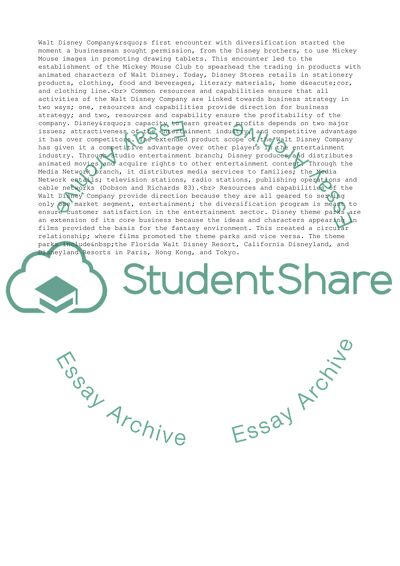Cite this document
(Diversification at the Walt Disney Company Case Study, n.d.)
Diversification at the Walt Disney Company Case Study. Retrieved from https://studentshare.org/management/1641151-what-are-and-how-do-common-resources-and-capabilities-link-activities-at-disney-discuss-and-evaluate-disneys-various-diversification-moves-in-terms-of-relatedness-in-2009-disney-announced-that-it-had-acquired-marvel-entertainment-a-comic-book-and
Diversification at the Walt Disney Company Case Study. Retrieved from https://studentshare.org/management/1641151-what-are-and-how-do-common-resources-and-capabilities-link-activities-at-disney-discuss-and-evaluate-disneys-various-diversification-moves-in-terms-of-relatedness-in-2009-disney-announced-that-it-had-acquired-marvel-entertainment-a-comic-book-and
(Diversification at the Walt Disney Company Case Study)
Diversification at the Walt Disney Company Case Study. https://studentshare.org/management/1641151-what-are-and-how-do-common-resources-and-capabilities-link-activities-at-disney-discuss-and-evaluate-disneys-various-diversification-moves-in-terms-of-relatedness-in-2009-disney-announced-that-it-had-acquired-marvel-entertainment-a-comic-book-and.
Diversification at the Walt Disney Company Case Study. https://studentshare.org/management/1641151-what-are-and-how-do-common-resources-and-capabilities-link-activities-at-disney-discuss-and-evaluate-disneys-various-diversification-moves-in-terms-of-relatedness-in-2009-disney-announced-that-it-had-acquired-marvel-entertainment-a-comic-book-and.
“Diversification at the Walt Disney Company Case Study”, n.d. https://studentshare.org/management/1641151-what-are-and-how-do-common-resources-and-capabilities-link-activities-at-disney-discuss-and-evaluate-disneys-various-diversification-moves-in-terms-of-relatedness-in-2009-disney-announced-that-it-had-acquired-marvel-entertainment-a-comic-book-and.


